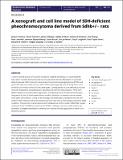| dc.contributor.author | Powers, James F | |
| dc.contributor.author | Cochran, Brent | |
| dc.contributor.author | Baleja, James D | |
| dc.contributor.author | Sikes, Hadley D | |
| dc.contributor.author | Pattison, Andrew D | |
| dc.contributor.author | Zhang, Xue | |
| dc.contributor.author | Lomakin, Inna | |
| dc.contributor.author | Shepard-Barry, Annette | |
| dc.contributor.author | Pacak, Karel | |
| dc.contributor.author | Moon, Sun Jin | |
| dc.contributor.author | Langford, Troy F | |
| dc.contributor.author | Stein, Kassi Taylor | |
| dc.contributor.author | Tothill, Richard W | |
| dc.contributor.author | Ouyang, Yingbin | |
| dc.contributor.author | Tischler, Arthur S | |
| dc.date.accessioned | 2021-10-27T20:29:59Z | |
| dc.date.available | 2021-10-27T20:29:59Z | |
| dc.date.issued | 2020 | |
| dc.identifier.uri | https://hdl.handle.net/1721.1/135930 | |
| dc.description.abstract | © 2020 The authors Tumors caused by loss-of-function mutations in genes encoding TCA cycle enzymes have been recently discovered and are now of great interest. Mutations in succinate dehydrogenase (SDH) subunits cause pheochromocytoma/paraganglioma (PCPG) and syndromically associated tumors, which differ phenotypically and clinically from more common SDH-intact tumors of the same types. Consequences of SDH deficiency include rewired metabolism, pseudohypoxic signaling and altered redox balance. PCPG with SDHB mutations are particularly aggressive, and development of treatments has been hampered by lack of valid experimental models. Attempts to develop mouse models have been unsuccessful. Using a new strategy, we developed a xenograft and cell line model of SDH-deficient pheochromocytoma from rats with a heterozygous germline Sdhb mutation. The genome, transcriptome and metabolome of this model, called RS0, closely resemble those of SDHB-mutated human PCPGs, making it the most valid model now available. Strategies employed to develop RS0 may be broadly applicable to other SDH-deficient tumors. | |
| dc.language.iso | en | |
| dc.publisher | Bioscientifica | |
| dc.relation.isversionof | 10.1530/ERC-19-0474 | |
| dc.rights | Creative Commons Attribution 4.0 International license | |
| dc.rights.uri | https://creativecommons.org/licenses/by/4.0/ | |
| dc.source | Society for Endocrinology | |
| dc.title | A xenograft and cell line model of SDH-deficient pheochromocytoma derived from Sdhb+/− rats | |
| dc.type | Article | |
| dc.contributor.department | Massachusetts Institute of Technology. Department of Chemical Engineering | |
| dc.relation.journal | Endocrine-Related Cancer | |
| dc.eprint.version | Final published version | |
| dc.type.uri | http://purl.org/eprint/type/JournalArticle | |
| eprint.status | http://purl.org/eprint/status/PeerReviewed | |
| dc.date.updated | 2021-06-17T15:34:23Z | |
| dspace.orderedauthors | Powers, JF; Cochran, B; Baleja, JD; Sikes, HD; Pattison, AD; Zhang, X; Lomakin, I; Shepard-Barry, A; Pacak, K; Moon, SJ; Langford, TF; Stein, KT; Tothill, RW; Ouyang, Y; Tischler, AS | |
| dspace.date.submission | 2021-06-17T15:34:26Z | |
| mit.journal.volume | 27 | |
| mit.journal.issue | 6 | |
| mit.license | PUBLISHER_CC | |
| mit.metadata.status | Authority Work and Publication Information Needed | |
